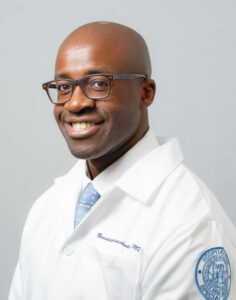Chondral Defect Hip Specialist

Chondral damage can occur from a traumatic accident (such as a hard fall), chronic injury from abnormalities in the shape of bones (i.e. femoroacetabular impingement), or from repetitive stresses occurring in sports or other activities. Common symptoms include hip joint pain ranging from dull to servere, pain that worsens with activity, decrease in range of motion, and a locking or catching sensation. Chondral defect specialist, Doctor Benedict Nwachukwu provides diagnosis as well as surgical and nonsurgical treatment options for patients in Manhattan, New York City, NY who have developed chondral damage. Contact Dr. Nwachukwu’s team today!
What is a chondral defect?
A chondral defect, or chondral damage is another term for an area of articular cartilage that is injured, or damaged. Articular cartilage is the tough, fibrous substance covering the surface of the bones within a joint. Often compared to the substance at the end of a chicken bone, this slippery matter is what allows for smooth motion between the ends of bones in a joint. Damage to healthy articular cartilage can lead to degenerative joint disease (such as arthritis) and joint pain. Over time, natural wear and tear of articular cartilage occur as a result of age, activity, or sporting events. Once a chondral defect has occurred, it has limited ability to heal or repair itself due to the lack of blood supply. Serving patients in Manhattan, New York City and the surrounding New York boroughs, Dr. Benedict Nwachukwu, specializes in a number of hip conditions including articular cartilage damage or chondral defects of the hip.

How does chondral damage occur?
Chondral damage can occur from a traumatic accident (such as a hard fall), chronic injury from abnormalities in the shape of bones (i.e. femoroacetabular impingement), or from repetitive stresses occurring in sports or other activities. These events can cause the cartilage to wear thin, break off or tear away from the bone, leading to a hip cartilage injury.
What are the symptoms of a chondral defect?
Patients report a dull, or sometimes severe pain in the hip joint. The pain worsens with activities. Other common symptoms include:
- Locking or catching sensation
- Significant decrease in range of motion
- A limp can be present with some cases of articular damage
How is articular damage in the hip diagnosed?
Dr. Nwachukwu will obtain a complete patient history to learn about the patient’s lifestyle (sports history) and any injury that may have taken place to the hip joint. An MRI is the best way to examine the articular cartilage within the hip joint; thus, Dr. Nwachukwu will commonly order an MRI scan to evaluate the cartilage and determine if a chondral defect of the hip exists.
How is a chondral defect of the hip treated?
Non-Surgical Treatment:
Some patients are able to live with the symptoms associated with chondral damage. They are able to manage pain with non-steroidal anti-inflammatory drugs (NSAIDs), ice, physical therapy, hip joint injections (steroid and platelet-rich plasma) and by avoiding activities contributing to flare-ups of pain. Patients who are not able to manage symptoms through these conservative measures may require a surgical procedure to help decrease the symptoms.
Surgical Treatment:
Cartilage defects have limited ability to heal or regenerate due to associated poor blood supply. In cases of severe chondral injury, where non-surgical treatments have failed to alleviate pain, surgery may be recommended. The type of treatment is very individualized and is based on the size and severity of the defect. Dr. Nwachukwu uses a variety of techniques:
- Chondroplasty – Also called debridement. Dr. Nwachukwu uses arthroscopic surgery to remove and clean out any unstable pieces of cartilage.
- Microfracture – Creates small fractures in the underlying bone to stimulate stem cells in the bone marrow. The process forces the body’s own healing factors to regrow cartilage.
- Osteochondral allograft transplantation – In select cases, cadaver (allograft) cartilage can be transplanted in order to replace the damaged portion of cartilage.
What is the recovery after chondral defect repair surgery?
Dr. Nwachukwu will provide a well-supervised physical therapy program to begin immediately following hip surgery. It is essential that movement and mobility begin right away, but with slow movements, so that a normal range of motion can be achieved over time. It is very important that patients follow the protocol for post-operative recovery as set forth by Dr. Nwachukwu and his staff. The same protocol will be provided so that therapy can be performed at home.
For additional resources on chondral defects of the hip and on hip cartilage injury, or to learn more about the techniques and procedures for chondral damage, please contact the office of Benedict Nwachukwu, MD, orthopedic hip specialist serving Manhattan, New York City, and surrounding New York boroughs.